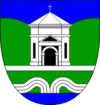Stubičke toplice
| Stubičke toplice | ||
|
||
|
|
||
| Basic data | ||
|---|---|---|
| State : |
|
|
| County : |
|
|
| Area : | 27 km² | |
| Residents : | 2,805 (2011) | |
| Population density : | 104 inhabitants per km² | |
| Telephone code : | (+385) 049 | |
| Postal code : | 49 244 | |
| License plate : | KR | |
| Structure and administration (status: 2013, cf. ) |
||
| Community type : | local community | |
| Mayor : | Vladimir Bosnar ( DC ) | |
| Website : | ||
Stubičke toplice (Stubica-Töplitz) is a village in the Krapina-Zagorje County , about 20 kilometers north of Zagreb in Croatia . It is known for its warm springs.
local community
The municipality consists of four settlements on an area of 27 km 2 and, according to the 2011 census, has 2,805 inhabitants (98.11% of Croatian descent). It is divided into four parts: Stubičke Toplice, Strmec Stubički, Pila and Sljeme.
Thermal springs
location
The thermal springs are not far from the village of Donja Stubica at the northwestern foot of Mount Kamenjak. The center is located near the confluence of the two rivers Vukšenac and Vidak potok to Toplicki potok (Toplica). Warm springs are also located two kilometers northeast of it, by the group of houses Jezerčica (warm pools).
history
The thermal springs were first mentioned as Zlubiza in a document from 1205, which documented a land return between King Andrew II of Hungary and the Comes Wratislaw.
Until the beginning of the 19th century, the warm springs were used in their simplest form. People bathed in wooden vessels in the open air and lodged in simple local inns. It was customary to purify blood with all sorts of means of traditional quackery. The rural population in particular took advantage of the opportunities offered by the spa.
When Agramer Bishop Maximilian Vrhovac von Rakitovecs brought the region into his possession around 1820, the expansion of the area into a spa began with fortified buildings, some of which are still preserved today. An important structural expansion did not take place again until 1895.
The extensions after 1820 aroused scientific interest in the springs and the surrounding area. On behalf of the Agriculture Society in Steyermark under the presidency of Archduke Johann, the sources were examined for the first time from a contemporary scientific perspective. In the publication from 1820, physical-chemical investigation of the mineral springs of Sztubitza in Croatia , Friedrich Baumbach presented a description of the source area including a copperplate view and a site plan.
In 1856, Karl Ritter von Hauer carried out a chemical analysis of the sources.
Inadequate water regulations caused the bathing area to be flooded several times in the 19th century. In response to this, several straightening works and backfills were carried out in the riparian zones.
Source types
There are cold and warm water sources in the area. The water temperatures fluctuate between 43 and 69 ° C depending on the source and the season .
The following are known of hot water sources (temperatures according to data from 1910):
- Maximilianeum (50 ° C)
- Main spring (59 ° C)
- Meadow spring (44 ° C)
- Antonia mud bath (several springs, formerly a mud pit)
- Levin fountain
- Levin spring (63 ° C)
- Bridge source (63 ° C)
and outside the bathing area:
- Jezerčica (Warm Pond), at the western end of Donja Stubica
geology
The hot water sources come from three parallel crevices in which the water penetrates upwards. You steichen in the direction NE-SW. During the investigations of Dragutin Gorjanović-Kramberger , Leitha limestone (with lithothamnia ) from the Miocene and overlying light yellow plate limestone marl were found as the main rock in the vicinity . The valley floor is formed by alluvial sediments.
Warm water escapes from many parts of the Toplica creek and thus increases the temperature of the creek until the Vidakbach flows into the side. Overall, a significantly higher soil temperature was found on the premises of the spa. The thermal springs of Stubičke Toplice are among the warmest of their kind in Croatia.
According to studies by Ferdo Koch and Mijo Kišpatić, the sludge carried by the rising spring waters is a mixture of quartz , feldspar , tourmaline , epidote , muscovite , iron oxides, pyroxene and calcite . Lime sinter is deposited especially at the main source.
See also
literature
- Gorjanović-Kramberger / Chr. Baron Steeb / Milan Melkus: The geological and hydrographic conditions of the thermal bath "Stubičke Toplice" in Croatia and their chemical-physical properties . in: JB dkk geol. Reichsanstalt, Vol. 60 (1910), 1st issue, pp. 1-66

